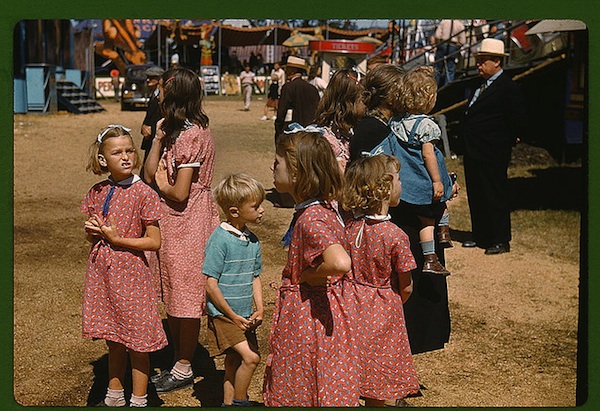Vintage color photographs from World War II era provoke technical mystery
posted Monday, October 15, 2012 at 5:14 PM EDT

Recently the Library of Congress published a very unusual gallery of gorgeous color photographs taken between 1939 and 1944 that seem to cover the entire range of American life, from rural and farm life to World War II mobilization. They were, in fact, taken by a variety of photographers working for the United States Farm Security Administration and the Office of War Information.
To truly appreciate the astonishing quality of these photographs, you need appraise them in a historical context. To our modern eyes, we might just see a set of well-made photographs from the past. However, they appear to be far ahead of their time, especially the capabilities of the color film of that era. In the early 1940s, Kodachrome was available on a very limited basis, and to the best of my knowledge it only came in ISO 16.
In these images, I see a lot of depth of field, which requires lenses to be stopped down to f/11 or smaller and long exposure times. The "Sunny 16 Rule" tells us that in bright sunlight the correct exposure time for a photograph at f/16 is 1/ISO. In this case, that is f/16 at 1/15th second or f/8 at 1/60th of second. In those days, long before Image Stabilization, shooting at these long exposure times required a tripod. Yet, remarkably, images like the State Fair (below) have the feeling of a grab shot, capturing a moment in time. The action is frozen, the subjects aren't blurry.

At the Vermont State Fair, Rutland, Vt.
Photograph taken by Jack Delano, September 1941.
There is another quality of the images, the roundness of the tonality, that leads me to suspect that these were shot with medium format 120mm (2 ¼ inch) or larger cameras of that period. (Ed. note: The Library of Congress states that the original images are color transparencies ranging in size from 35mm to 4x5 inches.) I'd love to know the nitty gritty details about each of these color images, because they're unlike anything I've ever seen from that era. Each is sharp and clear, with great skin tones and the peculiar roundness of image tones I associate with my old Rolleiflex f/3.5.
Which is another mystery, how did the photographers achieve such great color balance? These images are amazingly clean with true whites, and colors that are only slightly warm in a few of the images. But remember that film is balanced for either daylight or tungsten, and yet these images include pictures taken in both daylight and some made with accessory lighting.

Operating a hand drill at Vultee-Nashville, woman is working on a "Vengeance" dive bomber.
Photograph taken by Alfred T. Palmer, February 1943
We see it particularly clearly in the images of the women working for the World War II cause, including a veritable "Rosie the Riveter" (above). I am stunned by the purity of the light. But how was that achieved? From the other images, the color film appears daylight balanced. If the lighting source for the interior photos was (most likely) a single large floodlight, how did the photographer adjust for the tungsten bulb's yellow-red light? The shadowing seems to indicate that a single powerful light was used, with no diffusion. Was a blue filter placed over the lens to correct the floodlight? If so, that would have reduced the film’s ISO to effective ISO 8 or less. Yet look how sharp the details are -- the woman's hair, the air vents on the rivet gun.
I am at a loss to understand how this was done. It's possible that all the images were color corrected in Photoshop as they were scanned. In any case, I still wish we had more details about the photographers and what techniques and technology they used for these shots.
Please go check out these rare color photos for yourself, and let me know if you have any insights about them so we can unravel this decades-old photographic mystery together.
All photographs courtesy of the Library of Congress, Prints & Photographs Division, FSA-OWI Collection.